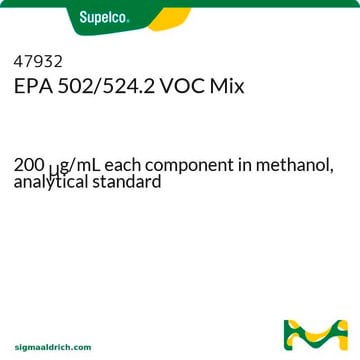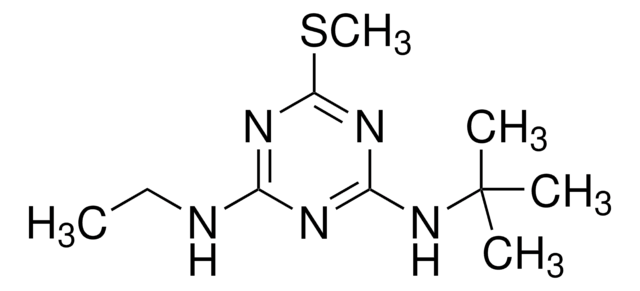47278
Bromodichloroacetic acid solution
certified reference material, 1000 μg/mL in methyl tert-butyl ether
Sign Into View Organizational & Contract Pricing
All Photos(1)
About This Item
Empirical Formula (Hill Notation):
C2HBrCl2O2
CAS Number:
Molecular Weight:
207.84
EC Number:
UNSPSC Code:
12000000
Recommended Products
grade
certified reference material
TraceCERT®
agency
EPA 552.2
product line
TraceCERT®
CofA
current certificate can be downloaded
feature
standard type calibration
packaging
ampule of 1 mL
concentration
1000 μg/mL in methyl tert-butyl ether
technique(s)
HPLC: suitable
gas chromatography (GC): suitable
application(s)
environmental
format
single component solution
storage temp.
2-8°C
InChI
1S/C2HBrCl2O2/c3-2(4,5)1(6)7/h(H,6,7)
InChI key
XSWVFEQKZFUULO-UHFFFAOYSA-N
Application
Refer to the product′s Certificate of Analysis for more information on a suitable instrument technique. Contact Technical Service for further support.
Other Notes
This Certified Reference Material (CRM) is produced and certified in accordance with ISO 17034 and ISO/IEC 17025. All information regarding the use of this CRM can be found on the certificate of analysis.
Legal Information
TraceCERT is a registered trademark of Merck KGaA, Darmstadt, Germany
signalword
Danger
hcodes
Hazard Classifications
Flam. Liq. 2 - Skin Irrit. 2
Storage Class
3 - Flammable liquids
wgk_germany
WGK 1
flash_point_f
-18.4 °F - closed cup
flash_point_c
-28 °C - closed cup
Choose from one of the most recent versions:
Already Own This Product?
Find documentation for the products that you have recently purchased in the Document Library.
William M Gwinn et al.
Toxicological sciences : an official journal of the Society of Toxicology, 176(2), 343-354 (2020-06-04)
A 5-day in vivo rat model was evaluated as an approach to estimate chemical exposures that may pose minimal risk by comparing benchmark dose (BMD) values for transcriptional changes in the liver and kidney to BMD values for toxicological endpoints
E W Austin et al.
Journal of toxicology and environmental health, 52(4), 367-383 (1997-11-14)
Haloacetates are a common class of water chlorination by-products. Depending on the amount of bromide in the source water, varying amounts of chlorinated, brominated, and mixed bromochloro haloacetates are produced. When administered to rodents, haloacetates have been shown to increase
J L Merdink et al.
Journal of applied toxicology : JAT, 21(1), 53-57 (2001-02-17)
The oral and i.v. elimination kinetics were investigated for bromodichloroacetate (BDCA), a haloacetate found in drinking water. The BDCA was administered at a dose of 5, 20 and 100 mg kg-1 to B6C3F1 mice and appears to distribute to the
G Xu et al.
Drug metabolism and disposition: the biological fate of chemicals, 23(12), 1412-1416 (1995-12-01)
Trichloroacetate (TCA), dichloroacetate (DCA), and bromodichloroacetate (BDCA) are byproducts of the chlorination of drinking water. TCA acts primarily as a peroxisome proliferator, but DCA produces tumors at doses less than required for peroxisome proliferation. BDCA does not induce peroxisome proliferation
Shakil A Saghir et al.
International journal of toxicology, 30(5), 551-561 (2011-09-22)
This study determined the metabolism of 3 drinking water disinfection by-products (halogenated acetic acids [HAAs]), bromodichloroacetic acid (BDCAA), chlorodibromoacetic acid (CDBAA), and tribromoacetic acid (TBAA), using rat, mouse, human liver microsomes, and recombinant P450. Metabolism proceeded by reductive debromination forming
Our team of scientists has experience in all areas of research including Life Science, Material Science, Chemical Synthesis, Chromatography, Analytical and many others.
Contact Technical Service










